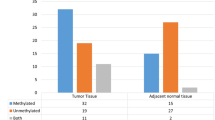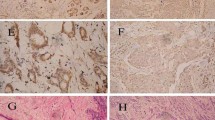Abstract
Hypermethylation of promoter CpG islands represents an alternative mechanism to inactivate tumor suppressor genes. This study was to detect promoter methylation status and mRNA expression levels of ARRDC3, ELP3, GATA5, and PAX6, and to explore the association between methylation and expression in invasive ductal carcinomas (IDCs) and matched normal tissues (MNTs) from breast cancer patients. Aberrant gene methylation was observed as follows: ARRDC3 in 38.5 %, ELP3 in 73.1 %, GATA5 in 48.1 %, and PAX6 in 50.0 % of IDCs. mRNA expression of ARRDC3, ELP3, and GATA5 in IDCs showed a lower level than that in MNTs (P < 0.001, P = 0.001 and P < 0.001, respectively). For ARRDC3, both methylated and unmethylated IDCs showed significantly lower expression values compared to MNTs (P = 0.001 and P = 0.007, respectively). For ELP3 and GATA5, methylated tumors only showed significantly lower expression values compared to MNTs (P = 0.001 and P < 0.001, respectively). For ARRDC3 and GATA5, methylation was associated with their less fold change in IDCs (P = 0.049 and P = 0.020, respectively). Methylation of ARRDC3 was significantly associated with grades and lymph node status of IDCs (P = 0.036 and P = 0.002, respectively). Methylation frequency of ELP3 was higher in lymph node positive versus lymph node negative tumors (P = 0.020); whereas methylation frequency of PAX6 was lower in tumors with the ER negative samples (P = 0.025). Our data suggested that promoter hypermethylation may be an important mechanism of the transcriptional inactivation of ARRDC3, GATA5, and ELP3 in IDCs.




Similar content being viewed by others
References
Chen WQ, Zeng HM, Zheng RS, Zhang SW, He J (2012) Cancer incidence and mortality in china, 2007. Chin J Cancer Res 24(1):1–8. doi:10.1007/s11670-012-0001-6
Harris JR, Lippman ME, Morrow M, Osborne CK (eds) (2000) Diseases of the breast, 2nd edn. Lippincott Willams & Wilkins, Philadelphia
Baylin SB, Herman JG (2000) DNA hypermethylation in tumorigenesis—epigenetics joins genetics. Trends Genet 16(4):168–174. doi:10.1016/s0168-9525(99)01971-x
Lamy A, Sesboue R, Bourguignon J, Dautreaux B, Metayer J, Frebourg T, Thiberville L (2002) Aberrant methylation of the CDKN2a/p16INK4a gene promoter region in preinvasive bronchial lesions: a prospective study in high-risk patients without invasive cancer. Int J Cancer 100(2):189–193. doi:10.1002/ijc.10474
Levenson VV (2007) Biomarkers for early detection of breast cancer: what, when, and where? Biochim Biophys Acta-Gen Subj 1770(6):847–856. doi:10.1016/j.bbagen.2007.01.017
Park SY, Kwon HJ, Lee HE, Ryu HS, Kim SW, Kim JH, Kim IA, Jung N, Cho NY, Kang GH (2011) Promoter CpG island hypermethylation during breast cancer progression. Virchows Arch 458(1):73–84. doi:10.1007/s00428-010-1013-6
Jovanovic J, Ronneberg JA, Tost J, Kristensen V (2010) The epigenetics of breast cancer. Mol Oncol 4(3):242–254. doi:10.1016/j.molonc.2010.04.002
Fackler MJ, McVeigh M, Evron E, Garrett E, Mehrotra J, Polyak K, Sukumar S, Argani P (2003) DNA methylation of RASSF1A, Hin-1, RAR-beta, cyclin D2 and twist in in situ and invasive lobular breast carcinoma. Int J Cancer 107(6):970–975. doi:10.1002/ijc.11508
Lee JS (2007) GSTP1 promoter hypermethylation is an early event in breast carcinogenesis. Virchows Arch 450(6):637–642. doi:10.1007/s00428-007-0421-8
Muggerud AA, Ronneberg JA, Warnberg F, Botling J, Busato F, Jovanovic J, Solvang H, Bukholm I, Borresen-Dale AL, Kristensen VN, Sorlie T, Tost J (2010) Frequent aberrant DNA methylation of ABCB1, FOXC1, PPP2R2B and PTEN in ductal carcinoma in situ and early invasive breast cancer. Breast Cancer Res 12(1). doi:10.1186/bcr2466
Moelans CB, Verschuur-Maes AHJ, van Diest PJ (2011) Frequent promoter hypermethylation of BRCA2, CDH13, MSH6, PAX5, PAX6 and WT1 in ductal carcinoma in situ and invasive breast cancer. J Pathol 225(2):222–231. doi:10.1002/path.2930
Peng Z, Shen R, Li YW, Teng KY, Shapiro CL, Lin HJ (2012) Epigenetic repression of RARRES1 is mediated by methylation of a proximal promoter and a loss of CTCF binding. PLoS ONE 7(5):e36891. doi:10.1371/journal.pone.0036891
Adelaide J, Finetti P, Bekhouche I, Repellini L, Geneix J, Sircoulomb F, Jauffret EC, Cervera N, Desplans J, Parzy D, Schoenmakers E, Viens P, Jacquemier J, Birnbaum D, Bertucci F, Chaffanet M (2007) Integrated profiling of basal and luminal breast cancers. Cancer Res 67(24):11565–11575. doi:10.1158/0008-5472.can-07-2536
Draheim KM, Chen HB, Tao Q, Moore N, Roche M, Lyle S (2010) ARRDC3 suppresses breast cancer progression by negatively regulating integrin beta 4. Oncogene 29(36):5032–5047. doi:10.1038/onc.2010.250
Rafiq S, Tapper W, Collins A, Khan S, Politopoulos I, Gerty S, Blomqvist C, Couch FJ, Nevanlinna H, Liu JJ, Eccles D (2013) Identification of inherited genetic variations influencing prognosis in early-onset breast cancer. Cancer Res 73(6):1883–1891. doi:10.1158/0008-5472.can-12-3377
Singh MK, Li Y, Li SR, Cobb RM, Zhou D, Lu MM, Epstein JA, Morrisey EE, Gruber PJ (2010) Gata4 and Gata5 cooperatively regulate cardiac myocyte proliferation in mice. J Biol Chem 285(3):1765–1772. doi:10.1074/jbc.M109.038539
Strachan T, Read AP (1994) PAX genes. Curr Opin Genet Dev 4(3):427–438
Chmelarova M, Krepinska E, Spacek J, Laco J, Nekvindova J, Palicka V (2012) Methylation analysis of tumour suppressor genes in ovarian cancer using MS-MLPA. Folia Biol 58(6):246–250
Belinsky SA, Grimes MJ, Casas E, Stidley CA, Franklin WA, Bocklage TJ, Johnson DH, Schiller JH (2007) Predicting gene promoter methylation in non-small-cell lung cancer by evaluating sputum and serum. Br J Cancer 96(8):1278–1283. doi:10.1038/sj.bjc.6603721
Hellebrekers D, Lentjes M, van den Bosch SM, Melotte V, Wouters KAD, Daenen KLJ, Smits KM, Akiyama Y, Yuasa Y, Sanduleanu S, Khalid-de Bakker CAJ, Jonkers D, Weijenberg MP, Louwagie J, van Criekinge W, Carvalho B, Meijer GA, Baylin SB, Herman JG, de Bruine AP, van Engeland M (2009) GATA4 and GATA5 are potential tumor suppressors and biomarkers in colorectal cancer. Clin Cancer Res 15(12):3990–3997. doi:10.1158/1078-0432.ccr-09-0055
Agundez M, Grau L, Palou J, Algaba F, Villavicencio H, Sanchez-Carbayo M (2011) Evaluation of the methylation status of tumour suppressor genes for predicting bacillus Calmette–Guerin response in patients with T1G3 high-risk bladder tumours. Eur Urol 60(1):131–140. doi:10.1016/j.eururo.2011.04.020
Peters I, Eggers H, Waalkes S, Hennenlotter J, Merseburger AS, Kuczyk MA, Serth J (2011) GATA5 promoter methylation is associated with metastasis and progression free survival in renal cell cancer patients. Eur Urol Suppl 10(2):106–107
Cosialls AM, Santidrian AF, Coll-Mulet L, Iglesias-Serret D, Gonzalez-Girones DM, Perez-Perarnau A, Rubio-Patino C, Gonzalez-Barca E, Alonso E, Pons G, Gil J (2012) Epigenetic profile in chronic lymphocytic leukemia using methylation-specific multiplex ligation-dependent probe amplification. Epigenomics 4(5):491–501. doi:10.2217/epi.12.40
Furuta J, Nobeyama Y, Umebayashi Y, Otsuka F, Kikuchi K, Ushijima T (2006) Silencing of Peroxiredoxin 2 and aberrant methylation of 33 CpG islands in putative promoter regions in human malignant melanomas. Cancer Res 66(12):6080–6086. doi:10.1158/0008-5472.can-06-0157
Hellwinkel OJC, Kedia M, Isbarn H, Budaus L, Friedrich MG (2008) Methylation of the TPEF- and PAX6-promoters is increased in early bladder cancer and in normal mucosa adjacent to pTa tumours. BJU Int 101(6):753–757. doi:10.1111/j.1464-410X.2007.07322.x
Bennett LB, Schnabel JL, Kelchen JM, Taylor KH, Guo JY, Arthur GL, Papageorgio CN, Shi HD, Caldwell CW (2009) DNA hypermethylation accompanied by transcriptional repression in follicular lymphoma. Gene Chromosomes Cancer 48(9):828–841. doi:10.1002/gcc.20687
Mishra DK, Chen ZJ, Wu YY, Sarkissyan M, Koeffler HP, Vadgama JV (2010) Global methylation pattern of genes in androgen-sensitive and androgen-independent prostate cancer cells. Mol Cancer Ther 9(1):33–45. doi:10.1158/1535-7163.mct-09-0486
Gyobu K, Yamashita S, Matsuda Y, Igaki H, Niwa T, Oka D, Kushima R, Osugi H, Lee S, Suehiro S, Ushijima T (2011) Identification and validation of DNA methylation markers to predict lymph node metastasis of esophageal squamous cell carcinomas. Ann Surg Oncol 18(4):1185–1194. doi:10.1245/s10434-010-1393-5
Yao DM, Shi J, Shi BY, Wang N, Liu W, Zhang GJ, Ji MJ, Xu L, He NY, Hou P (2012) Quantitative assessment of gene methylation and their impact on clinical outcome in gastric cancer. Clin Chim Acta 413(7–8):787–794. doi:10.1016/j.cca.2012.01.013
Elston CW, Ellis IO (1991) Pathological prognostic factors in breast cancer. I. The value of histological grade in breast cancer: experience from a large study with long-term follow-up. Histopathology 19(5):403–410
Singletary SE, Allred C, Ashley P, Bassett LW, Berry D, Bland KI, Borgen PI, Clark GM, Edge SB, Hayes DF, Hughes LL, Hutter RV, Morrow M, Page DL, Recht A, Theriault RL, Thor A, Weaver DL, Wieand HS, Greene FL (2003) Staging system for breast cancer: revisions for the 6th edition of the AJCC Cancer Staging Manual. Surg Clin North Am 83(4):803–819. doi:10.1016/s0039-6109(03)00034-3
Li LC, Dahiya R (2002) MethPrimer: designing primers for methylation PCRs. Bioinformatics 18(11):1427–1431. doi:10.1093/bioinformatics/18.11.1427
Herman JG, Graff JR, Myohanen S, Nelkin BD, Baylin SB (1996) Methylation-specific PCR: a novel PCR assay for methylation status of CpG islands. Proc Natl Acad Sci USA 93(18):9821–9826. doi:10.1073/pnas.93.18.9821
Bustin SA, Benes V, Garson JA, Hellemans J, Huggett J, Kubista M, Mueller R, Nolan T, Pfaffl MW, Shipley GL, Vandesompele J, Wittwer CT (2009) The MIQE guidelines: minimum information for publication of quantitative real-time PCR experiments. Clin Chem 55(4):611–622. doi:10.1373/clinchem.2008.112797
Charafe-Jauffret E, Ginestier C, Monville F, Fekairi S, Jacquemier J, Birnbaum D, Bertucci F (2005) How to best classify breast cancer: conventional and novel classifications (review). Int J Oncol 27(5):1307–1313
Lyon CM, Klinge DM, Liechty KC, Gentry FD, March TH, Kang T, Gilliland FD, Adamova G, Rusinova G, Telnov V, Belinsky SA (2007) Radiation-induced lung adenocarcinoma is associated with increased frequency of genes, inactivated by promoter hypermethylation. Radiat Res 168(4):409–414. doi:10.1667/rr0825.1
Chen BH, Hsu RN, Li ZP, Kogut PC, Du QX, Rouser K, Camoretti-Mercado B, Solway J (2012) Upstream stimulatory factor 1 activates GATA5 expression through an E-box motif. Biochem J 446:89–98. doi:10.1042/bj20111942
Robson EJD, He SJ, Eccles MR (2006) A PANorama of PAX genes in cancer and development. Nat Rev Cancer 6(1):52–62. doi:10.1038/nrc1778
Gao J, Wang J, Wang YM, Dai W, Lu L (2011) Regulation of Pax6 by CTCF during induction of mouse ES cell differentiation. PLoS One 6(6). doi:10.1371/journal.pone.0020954
Patwari P, Emilsson V, Schadt EE, Chutkow WA, Lee S, Marsili A, Zhang YZ, Dobrin R, Cohen DE, Larsen PR, Zavacki AM, Fong LG, Young SG, Lee RT (2011) The arrestin domain-containing 3 protein regulates body mass and energy expenditure. Cell Metab 14(5):671–683. doi:10.1016/j.cmet.2011.08.011
Patwari P, Lee RT (2012) An expanded family of arrestins regulate metabolism. Trends Endocrinol Met 23(5):216–222. doi:10.1016/j.tem.2012.03.003
Nabhan JF, Pan H, Lu Q (2010) Arrestin domain-containing protein 3 recruits the NEDD4 E3 ligase to mediate ubiquitination of the beta2-adrenergic receptor. EMBO Rep 11(8):605–611. doi:10.1038/embor.2010.80
Soung YH, Pruitt K, Chung J (2014) Epigenetic silencing of ARRDC3 expression in basal-like breast cancer cells. Sci Rep 4:3846. doi:10.1038/srep03846
Svejstrup JQ (2007) Elongator complex: how many roles does it play? Curr Opin Cell Biol 19(3):331–336. doi:10.1016/j.ceb.2007.04.005
Close P, Hawkes N, Cornez I, Creppe C, Lambert CA, Rogister B, Siebenlist U, Merville MP, Slaugenhaupt SA, Bours V, Svejstrup JQ, Chariot A (2006) Transcription impairment and cell migration defects in elongator-depleted cells: implication for familial dysautonomia. Mol Cell 22(4):521–531. doi:10.1016/j.molcel.2006.04.017
Huang B, Johansson MJO, Bystrom AS (2005) An early step in wobble uridine tRNA modification requires the elongator complex. Rna 11(4):424–436. doi:10.1261/rna.7247705
Okada Y, Yamagata K, Hong K, Wakayama T, Zhang Y (2010) A role for the elongator complex in zygotic paternal genome demethylation. Nature 463(7280):U177–U554. doi:10.1038/nature08732
Li Q, Fazly AM, Zhou H, Huang SB, Zhang ZG, Stillman B (2009) The Elongator complex interacts with PCNA and modulates transcriptional silencing and sensitivity to DNA damage agents. Plos Genet 5(10). doi:10.1371/journal.pgen.1000684
Acknowledgments
This study was supported by National Natural Science Foundation of China; Grant number: 81070452, National Research Foundation for Doctoral Program of Higher Education of China, Grant number: 20090181110048.
Author information
Authors and Affiliations
Corresponding authors
Electronic supplementary material
Below is the link to the electronic supplementary material.
Rights and permissions
About this article
Cite this article
Wang, D., Yang, PN., Chen, J. et al. Promoter hypermethylation may be an important mechanism of the transcriptional inactivation of ARRDC3, GATA5, and ELP3 in invasive ductal breast carcinoma. Mol Cell Biochem 396, 67–77 (2014). https://doi.org/10.1007/s11010-014-2143-y
Received:
Accepted:
Published:
Issue Date:
DOI: https://doi.org/10.1007/s11010-014-2143-y




